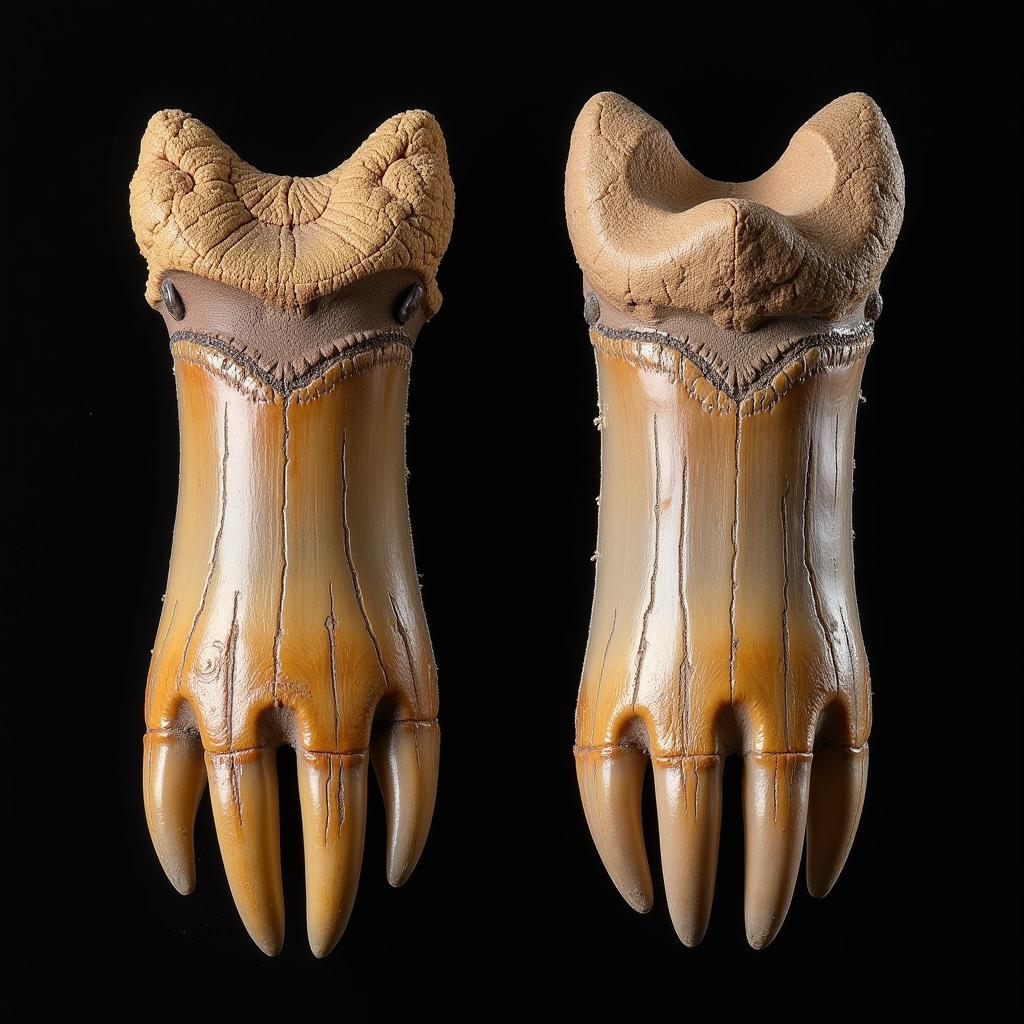3 Toed Horse Teeth offer a fascinating glimpse into the evolutionary history of these magnificent creatures. By studying these ancient remnants, we can learn a great deal about the diets, habitats, and lifestyles of prehistoric horses. This article will delve into the world of 3 toed horse teeth, exploring their unique characteristics and what they reveal about the past.
What Makes 3 Toed Horse Teeth Unique?
Unlike modern horses, which typically have single-toed hooves, their ancestors sported three toes. This difference is reflected in their dental structure as well. 3 toed horse teeth often exhibit more complex crown patterns and larger overall size compared to their modern counterparts. These features are indicative of a diet primarily consisting of browse, such as leaves and twigs, rather than the grasses favored by today’s horses. The shape and wear patterns on these teeth provide valuable clues about the types of vegetation consumed and the environment these animals inhabited. Did you know that the angle of wear on a 3 toed horse tooth can even suggest whether the animal primarily grazed or browsed?
Furthermore, examining the fossilized remains of 3 toed horse teeth can help us trace the evolutionary lineage of horses. By comparing the dental characteristics of different species, scientists can construct a detailed picture of how horses have changed over millions of years. The size, shape, and enamel patterns of these teeth serve as essential markers in understanding horse evolution.
A Window into the Prehistoric World: Studying 3 Toed Horse Teeth
The study of 3 toed horse tooth provides invaluable insights into the past. Paleontologists carefully analyze fossilized horse teeth to reconstruct ancient ecosystems and understand the environmental pressures that shaped horse evolution. For example, the presence of certain isotopes in the teeth can reveal information about the animal’s diet and the climate it lived in.
“The teeth of extinct horses are like tiny time capsules,” explains Dr. Emily Carter, a renowned paleontologist specializing in equine evolution. “They hold a wealth of information about the animal’s life and the world it inhabited.”
Understanding the Diet of 3 Toed Horses
The diet of 3 toed horses played a crucial role in their evolutionary trajectory. Their teeth, specifically adapted for browsing, allowed them to thrive in forested environments. As grasslands expanded, however, horses with teeth better suited for grazing gained an advantage. This shift in diet is evident in the fossil record, where we see a gradual change in tooth morphology over time.
“The transition from browsing to grazing is a fascinating example of adaptation in action,” adds Dr. Carter. “By studying 3 toed horse teeth, we can track this dietary shift and understand how it influenced the evolution of modern horses.”
 Comparison between 3 Toed Horse Teeth and Modern Horse Teeth
Comparison between 3 Toed Horse Teeth and Modern Horse Teeth
The Importance of Fossil Horse Teeth in Evolutionary Studies
The study of 3 toed horse teeth isn’t just about understanding the past; it also has implications for the future. By learning how horses adapted to past environmental changes, we can gain insights into how they might respond to future challenges, such as climate change and habitat loss. This knowledge is essential for developing effective conservation strategies and ensuring the long-term survival of these magnificent animals.
In conclusion, 3 toed horse teeth provide a unique window into the evolutionary history of horses. They reveal crucial information about the diets, habitats, and lifestyles of prehistoric horses, allowing us to trace their evolutionary journey and understand how they adapted to changing environments. This knowledge is not only fascinating but also essential for protecting the future of horses.
FAQ
- What is the difference between browsing and grazing?
- How can we determine the age of a fossilized horse tooth?
- Where are fossilized horse teeth typically found?
- What other types of fossils can provide information about prehistoric horses?
- How can the study of 3 toed horse teeth help with modern horse care?
- What are some common misconceptions about horse evolution?
- How can I learn more about paleontology and the study of fossils?
Interested in learning more about fossilized horse remnants? Check out our article on fossilized horse teeth.
Need support? Contact us at Phone: 0772127271, Email: [email protected], or visit us at QGM2+WX2, Vị Trung, Vị Thuỷ, Hậu Giang, Việt Nam. We have a 24/7 customer service team.